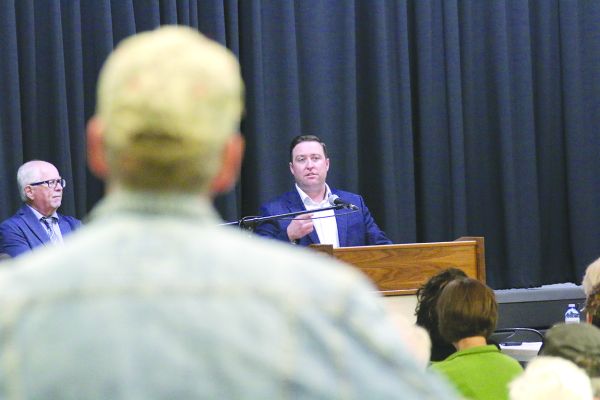Concerned citizens gathered for the Swan River Crime Meeting facilitated by the Town of Swan River on Wednesday, October 1, at the Veterans Hall. The meeting had many in attendance, both in-person and virtually, with the recording of the meeting gaining around 1,715 views in less than 24 hours.
Roger Bouvier was the moderator for the evening and this time the focus of the meeting was to answer questions from the public. In attendance to answer questions were: RCMP West District Staff Sergeant Scott Linklater; Swan River RCMP Corporal Cole Plaetinck; James Wigley, Stacy Grindle and Jakki Lumax for Canadian Mental Health; Andrew Minor, Executive Director of Manitoba Police Commission and Senior Advisor, Public Safety Division; Mark Lafreniere, Director of Manitoba Prosecution Services; Dr. Erin Knight, Health Sciences Centre; Lanna Many Grey Horses, Assistant Deputy Minister for Homelessness for the Manitoba Department of Housing, Homelessness and Addictions; Owen Fergusson, Assistant Deputy Minister for Manitoba Justice.
The following organizations were invited but declined: Shannon Isley, Director for Manitoba Harm Reduction; Treena Slate, CEO for Prairie Mountain Health; Province of Manitoba Department of Health and Office of the Chief Provincial Public Health Office.
There were some discussions regarding police staffing levels. Out of 22 regular members, there are 12 who are active for duty. The Swan River RCMP detachment is expecting three more members coming in around November. The GIS Unit positions are new ones, with the majority of the positions yet to be filled, except for the Corporal position, which has been given to a member who is on maternity leave currently. Staff Sergeant Linklater indicated that they are holding off on the constable positions because there has been some interest shown within the detachment for these positions. They don’t want to take members away from the regular detachment to fill the GIS Unit, so as the detachment numbers go back up, those positions will be filled.
“From July 1, 2024, to June 30, 2025, there have been 124 serious violent crime occurrences,” said Staff Sergeant Linklater. “That ranks amongst the top three detachments in the Manitoba West District and 14th in the division of 70 detachments.”
The stats presented indicated that property crime in the Swan Valley is trending below the five-year average in the most recent quarter. Within the same timeframe, there were 676 property crime occurrences that took place. This also placed Swan River in the top three detachments and sixth in the division for property crimes.
Shoplifting in Swan River is also trending below the five-year average, according to stats presented. The worst year for shoplifting occurrences in Swan River was in 2023, with 353 occurrences reported. This year, to date, there have been 56 shoplifting occurrences reported.
When it comes to repeat offenders, ten repeat offenders have caused 89 property crime occurrences, 43 person crime occurrences, 33 CDSA occurrences; 170 total occurrences under the criminal code in one calendar year. These repeat offenders have committed crimes not only in the Valley, but in Winnipegosis, Dauphin and Ste. Rose.
A question was asked about why there were so many repeat offenders. It was explained that there are a lot of proposed changes being made to the federal government about holding repeat offenders. Much of this is related to the Criminal Code, which is handled by the federal government, not the provincial government.
In Manitoba, specially tasked units have been created to focus on repeat offenders. An ankle monitoring program has also been established to help keep track of those who are out on bail or probation who have repeat offences in their criminal record.
Comments from attendees were that the data was cherry-picked, that bureaucrats are talking in circles and that a lot of people have given up on reporting the crime. Community member and lawyer, David Gray, pointed out that there were some issues with the meeting and that an agenda is not simply a list of speakers and the need for direct answers.
Some questions were asked about CMHA’s activities and why the building was put on Main Street. James Wigley took the time to explain to people about harm reduction. He explained that although CMHA does do harm reduction methods, they do not hand out sharps or do any medical type of harm reduction. CMHA focuses on housing, employment, education, life-skill training, rehabilitation and peer support as harm reduction methods. Health organizations and regions are the ones that handle the medical supplies for harm reduction.
Wigley did note that there has been tremendous success and progress in helping people; however, the need is so great that the general public is only seeing what is not working rather than what has worked.
Another question was asked about whether or not any of the municipalities had a say on whether or not harm reduction services would be offered in the community. Presenters stood by their stance that harm reduction saves lives, from naloxone to new needle distribution and is evidence-based. The same person talked about how the discarded needles are scattered all over public places, such as playgrounds, parks, and how there is now an HIV outbreak. They asked if this was not enabling the problem. The Assistant Deputy Minister for Homelessness did note that the province provided $45,000 for needle clean-up.
Questions stemmed around how to get rid of harm reduction supplies and the risk it has put people in the community at with all the discarded sharps. A direct question was asked on how to get harm reduction out of the community. No one on the panel was able to answer that question. Citizens asked Mayor Jacobson to ask this of the province and PMH, and to look how to get rid of handing out sharps in the Valley.
Print this page
Town hall on crime leaves more questions than answers
Published in Swan Valley Star and Times Community
Published in
Swan Valley Star and Times Community
Tagged under

